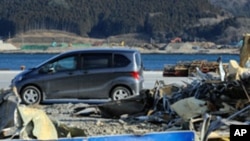Japan is planning to build six energy efficient so-called “future cities” in the region devastated by the magnitude 9.0 earthquake and tsunami one year ago. But there are concerns about the scope and sustainability of the projects and whether international entities will be shut out.
After the March 11, 2011 tsunami washed away some coastal communities and many of their inhabitants, many feared that some towns would disappear forever. But Japan is now planning to revive some of them as energy-efficient communities. Some of the ideas are quite ambitious.
A trio of devastated towns - Ofunato, Rikuzentakata and Sumida Kesen - would jointly become home to the world's first mega solar power project with locally distributed batteries.
Kamaishi plans to make its own electricity for local consumption and to create new industries. Higashi Matsushima is to use cutting edge building technology to create a disaster resistant community. Iwanuma could use debris from the natural disaster to redevelop a natural environment. It will also have a solar-powered smart electrical grid.
And the town of Shinichi plans to become an “information infrastructure hub” while Minamisoma is trying to be an “energy circulation” themed city, perhaps utilizing wind power.
Imported fossil fuels still power much of Japan’s economy, especially since nearly all of the country’s nuclear reactors are now offline for a variety of reasons. Authorities are seeking bold ideas for alternative energy.
At a seminar in Fukushima, some of those from the affected communities, international urban planners and diplomats received a briefing (on Friday) from the chairman of an academic group evaluating some cutting-edge proposals.
Architect and engineer Shuzo Murakami says “future city” residents would not only control their electrical usage, but also create and store energy in their own homes.
But Murakami cautions the new communities cannot be designed in a way that merely pours in money for construction. The new cities, he says, need to be self-sufficient and sustainable so people will want to live in them over the long term.
Even before last year's disaster some of the communities were facing big challenges. Younger residents had fled to bigger cities, abandoning jobs in farming and fishing.
Survivors and planners fear that the projects could be the latest version of billion-dollar boondoggles. Japan has seen many of those over the decades where politicians and construction companies collude, primarily for the financial benefit of each other.
Japan is encouraging foreign companies to participate in the rebuilding. But overseas groups complain they have found little actual enthusiasm for their expertise and products, both with the massive cleanup so far and the planned reconstruction efforts. Some have told VOA that Japanese middlemen have offered assistance only if bribes are paid.
A keynote speaker at the Fukushima seminar, Richard Jones, the deputy executive director of the International Energy Agency, says Japan's decision-makers need to focus on the needs of the people rather than the desires of major Japanese companies.
“Of course in a situation like this, there's always the temptation because, after all, they're spending a lot of public money to focus it on domestic sources," Jones stated. "But I would certainly urge people to try and think about the long term and also about the needs of the people in the area.
And, Jones says, the primary need in the devastated communities is reconstruction as quickly as possible. “I don't think they should try and reinvent the wheel when there are plenty of examples out there of other communities and other projects that have been quite successful,” he said.
Jones, a former U.S. ambassador to four countries, said smart communities in Denmark, England, Germany and Sweden are viable models for Japan to learn from.
Advocates says those lessons include how planning and construction must involve the future residents and other stakeholders to ensure that they are both energy efficient and desirable places to live.















